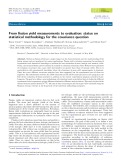
REGULAR ARTICLE
From fission yield measurements to evaluation: status on
statistical methodology for the covariance question
Brieuc Voirin
1,2
, Grégoire Kessedjian
1,*
, Abdelaziz Chebboubi
2
, Sylvain Julien-Laferrière
1,2
, and Olivier Serot
2
1
LPSC, Université Grenoble-Alpes, CNRS/IN2P3, 38026 Grenoble Cedex, France
2
CEA, DEN, DER, SPRC, LEPh, Cadarache Center, 13108 Saint Paul lez Durance, France
Received: 5 December 2017 / Received in final form: 21 March 2018 / Accepted: 14 May 2018
Abstract. Studies on fission yields have a major impact on the characterization and the understanding of the
fission process and are mandatory for reactor applications. Fission yield evaluation represents the synthesis of
experimental and theoretical knowledge to perform the best estimation of mass, isotopic and isomeric yields.
Today, the output of fission yield evaluation is available as a function of isotopic yields. Without the explicitness
of evaluation covariance data, mass yield uncertainties are greater than those of isotopic yields. This is in
contradiction with experimental knowledge where the abundance of mass yield measurements is dominant.
These last years, different covariance matrices have been suggested but the experimental part of those are
neglected. The collaboration between the LPSC Grenoble and the CEA Cadarache starts a new program in the
field of the evaluation of fission products in addition to the current experimental program at Institut Laue-
Langevin. The goal is to define a new methodology of evaluation based on statistical tests to define the different
experimental sets in agreement, giving different solutions for different analysis choices. This study deals with the
thermal neutron induced fission of
235
U. The mix of data is non-unique and this topic will be discussed using the
Shannon entropy criterion in the framework of the statistical methodology proposed.
1 Introduction
Fission yields are important nuclear data for fuel cycle
studies. The mass and isotopic yields of the fission
fragments have a direct influence on the amount of
neutron poisons that limit the fuel burnup but also on the
residual power of the reactor after shutdown. Nowadays,
fission yield evaluations are principally based on nuclear
measurements dedicated to the fission process in the past
and important information on systematic effects was not
considered.
Fission yield evaluation comes from data and models to
perform the best estimation of mass, isotopic and isomeric
yields. Nowaday, the mass yields are deduced from the sum
of the isotopic yields since it is the standard output of
evaluation files. But without any correlation matrix, their
uncertainties are greater for mass yields than for isotopic
yields. This is in contradiction with experimental knowl-
edge where the abundance of mass yield measurements is
clearly dominant and often more accurate than isotopic
yields. Thus, we expect the uncertainties on this latter
observable to be lower than those on isotopic yields. Even if
the isotopic yields are the interesting observables for the
applications, the mass yield measurements provide an
important constraint on the uncertainties of the isotopic
yields. The inconsistency of mass yield uncertainties comes
from the undefined covariance matrix in the current
evaluations. Nevertheless, the covariance matrix depends
on the evaluation process and its existence assumes that all
measurements are statistically in agreement. These last
years, different covariance matrices have been suggested
but the experimental part of those are not taken into
account [1–6].
Based on experimental knowledge on fission yield
measurements, the goal of this study is to define a new
methodology of evaluation based on statistical test to sort
the different experimental measurements. The second
section is devoted to introduce the tools needed in the
discussion on the compatibility of the data. The third
section deals with the data renormalization process and its
consequence. The fourth section discusses our evaluation
procedure according to the multiplicity of solutions.
Absolute normalization step of mass yields with associated
correlation matrix (Sect. 5) and the ranking of solutions
(Sect. 6) are described in the end. And finally, conclusion
and perspectives discuss the place of integral measure-
ments in the evaluation framework.
*e-mail: kessedjian@lpsc.in2p3.fr
EPJ Nuclear Sci. Technol. 4, 26 (2018)
©B. Voirin et al., published by EDP Sciences, 2018
https://doi.org/10.1051/epjn/2018030
Nuclear
Sciences
& Technologies
Available online at:
https://www.epj-n.org
This is an Open Access article distributed under the terms of the Creative Commons Attribution License (http://creativecommons.org/licenses/by/4.0),
which permits unrestricted use, distribution, and reproduction in any medium, provided the original work is properly cited.





















